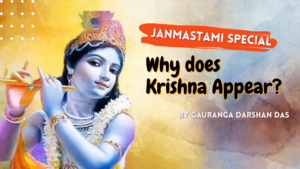Of all the twelve months in the Vedic Calendar, the month of Kartik is very special. Apart from being known as the month of ‘Damodar’, a name of Krishna, the word ‘Kartik’ is also one of the names of Srimati Radharani. Absorbing the unique honey-like blend of the names of Radha and Krishna, this is a month that offers sadhakas bountiful spiritual advancement in return for a little devotional service. Devotees observing the month of Kartik, especially in Vrindavan, become recipients of Srimati Radharani’s profuse blessings, and of the rarest bhakti that Sri Krishna lovingly bestows.
Śarad-pūrṇimā, the full-moon autumnal night, is considered to be the most beautiful night of the year. Although Kartik sets in the day after Śarad-pūrṇimā, excitement, and joy begin bubbling in the hearts of the devotees on the eve of Śarad-pūrṇimā. In fact, Lord Krishna enacted His divine Rasa dance with the gopīs of Vrindavan on the blessed night of Śarad-pūrṇimā. This Rasa dance is the topmost display of love between the Lord and His devotees. Thus, the full-moon night represents the epitome of spiritual ecstasy.
The month of Kartik is bedecked with many heartwarming festivals. Herein, is a description of some of them for you to relish.
Dīpāvalī: The Festival of Lamps
The month of Kartik appears gleamingly decorated on Dīpāvalī or Diwali, the festival of lamps. Although an Amavasya, a dark moon night, the soothing evening of Diwali dazzles in the light emanated by numerous earthen lamps. These lamps dispel the cold and darkness, both outside and within our hearts.
On this day, the deities are most pleasingly dressed while the ground is blanketed with colored powder designs (rangolis). Mouthwatering bhoga offerings and heart-melting kirtanas surcharge the festive spirit. To top all of this, nectarean Krishna-katha simply makes Diwali an unmatchable experience.
Just like a moonless Amavasya night, our hearts too have been enveloped in thick darkness for a long time. Maya plays the role of darkness, whereas Krishna takes up the role of light (krishna-surya sama maya haya andhakara) thereby driving away the darkness and illuminating our hearts from within. When we lovingly invite the Lord into our hearts, He lights up the lamp of divine knowledge and spiritual inspiration in our hearts, and drives away the darkness of ignorance (aham ajnana-jam tamah nasayamy atma-bhava-stho jnana-dipena bhasvata, BG 10.11). Offering the lamps of our love signifies dedicating our lives to His service. With such an enlivened and inspired heart, we engage in the service of the Lord enthusiastically. That is Diwali; a time to really focus on making our lives an offering to the Lord and inviting Him into our hearts, to stay in there forever.
A lovely pastime associated with Diwali is the Damodara-Lila in Vrindavan. It was the day of Diwali when Krishna demonstrated to the whole world, the power of His devotee’s love, which is the only thing that can conquer and bind Krishna. On that day, Mother Yashoda churned and made butter early in the morning, while being fully absorbed in the thoughts of Krishna, she sang songs that described His enchanting pastimes. Krishna then woke up from his sleep and went to Mother Yashoda, who then started lovingly feeding Him her milk. But she had to briefly interrupt her service to Krishna, to rescue some special milk that was spilling over the stovetop in the kitchen. This angered Krishna, who then broke the butter pot, stole the butter, and started distributing it to the monkeys.
Mother Yashoda then began chasing Krishna with a stick in her hand. Krishna began running away to escape chastisement from Mother Yashoda but was caught up in the end. Initially, Yashoda tried tying Krishna to the wooden grinding mortar but the rope appeared to be two fingers short no matter how hard she tried. But eventually, she could bind Krishna with the rope of her love. Since then, Krishna was called as Damodara. Dama means rope and udara means belly. Damodara means one whose belly is bound by the rope of His mother’s love.
darśayaṁs tad-vidāṁ loka
ātmano bhṛtya-vaśyatām
vrajasyovāha vai harṣaṁ
bhagavān bāla-ceṣṭitaiḥ
To pure devotees throughout the world who could understand His activities, the Supreme Personality of Godhead, Kṛṣṇa, exhibited how much He can be subdued by His devotees, His servants. In this way, He increased the pleasure of the Vrajavāsīs by His childhood activities. (SB 10.11.9)
Adoring this sweet pastime, devotees offer lamps of love (dipa-dana) to the deities of Yashoda-Damodara. Diwali evenings are most enlivening with the blissful melodies of the Damodarastakam reverberating in the air. This is a beautiful song by Satyavrata Muni, sung by the devotees. In this way, Diwali offers abundant spiritual advancement in devotional meditation.
Govardhana Puja: Worshiping the King among Mountains
Govardhana Puja is another jewel-like festival adorning the beautiful month of Kartik. Govardhana Puja immediately follows the day of Diwali. Traditionally, the residents of Vrindavana worshipped Indra, the King of Heaven and the supplier of rains. But upon noticing great pride in the heart of Indra, Lord Krishna desired to stop such worship. He inspired the residents of Vrindavana to worship Govardhana instead. Pleasing Krishna was the topmost priority of each resident of Vrindavana. So together, they worshipped and circumambulated Govardhan enthusiastically.
With joy overflowing in their hearts, devotees celebrate this day by circumambulating (parikramas) and replicating Govardhana by stacking up endless piles of delicious bhoga as an offering to Giriraj Govardhana, the king among mountains. This is popularly called the Annakuta ceremony celebrated in various parts of the world on this auspicious day. The devotees wholeheartedly worship Govardhana for they know that Krishna and Govardhana are non-different. Carrying this mood in our hearts as we near this wonderful festival, let’s worship Govardhana, the tilaka of Vraja with all our devotion, for this is the only way to satisfy His unabating hunger. Aniyor!
The devotees also worship of cows (go puja), the natural mothers of humanity on this day. Since Krishna Himself worshipped and protected cows, the devatas followed suit. In this way, Krishna personally established the importance of cow-worship on the day of Govardhana-pūjā.
Gopashtami: Krishna Becomes a Cowherd Boy
The month of Karthik also encapsulates the Gopashtami celebration. We find sastric pramāna (scriptural evidence) in the Kārttika-māhātmya section of the Padma Purana that reveals the origin of this festivity.
śuklāṣṭamī kārttike tu
smṛtā gopāṣṭamī budhaiḥ
tad-dinād vāsudevo ‘bhūd
gopaḥ pūrvaṁ tu vatsapaḥ
“On the eighth lunar day of the bright fortnight in the Kartik month, Lord Krishna took the calves for the first time for grazing at a very young age, and on the same day after a few years he took out the cows for grazing. This day is celebrated as Gopashtami.”
In the company of Their friends, Krishna and Balarama rendered the land of Vrindavan most auspicious by imprinting upon it the divine marks of Their lotus feet. The specialty of Vrindavan is that Krishna doesn’t even put on footwear while He walks through the dense groves of the forest. In the Venu-gita, the gopis praise the land of Vrindavan as follows:
vṛndāvanaṁ sakhi bhuvo vitanoti kīrtiṁ
yad devakī-suta-padāmbuja-labdha-lakṣmi
Vṛndāvana is spreading the glory of the earth, having obtained the treasure of the lotus feet of Kṛṣṇa, the son of Mother Yashoda.
Srimati Radharani and Her friends too wanted to enjoy the fun and join Krishna and the gopas as they were grazing in the forest. Radharani’s face resembles the face of Subala, an intimate friend of Krishna. So, she wore Subala’s garments and dressed Herself up like a cowherd boy, and joined Krishna.
On the eve of Gopashtami, devotees wake up early in the morning and bathe the cows. They worship the cows with incense, flowers, and clothes, and offer them jaggery, sweets, and a special feast!
Thus, preparing our consciousness for the amazing festivals that come during this Kartik, let’s inch forward towards Krishna as we travel forth in our spiritual journey.




